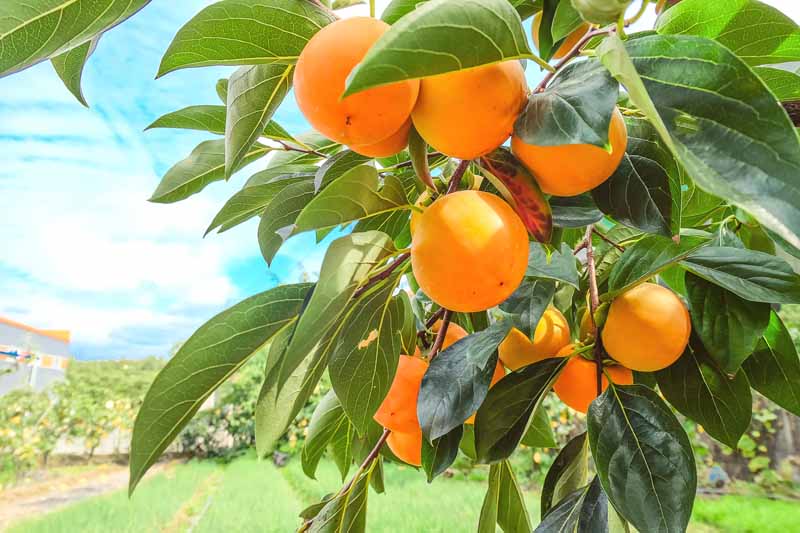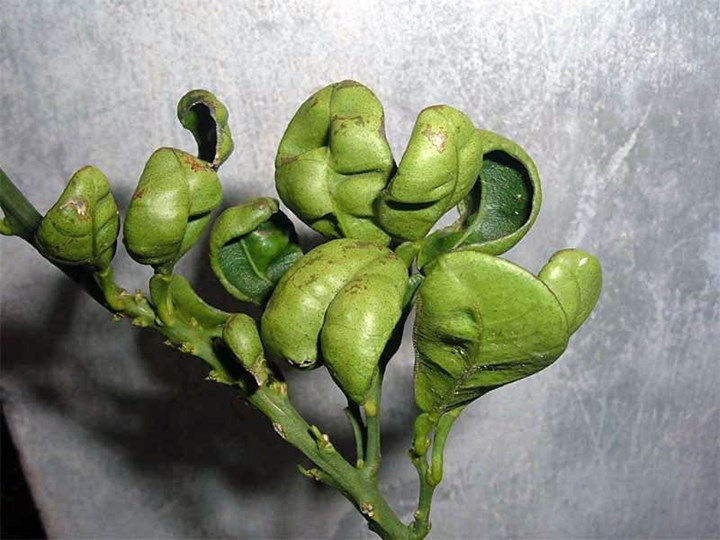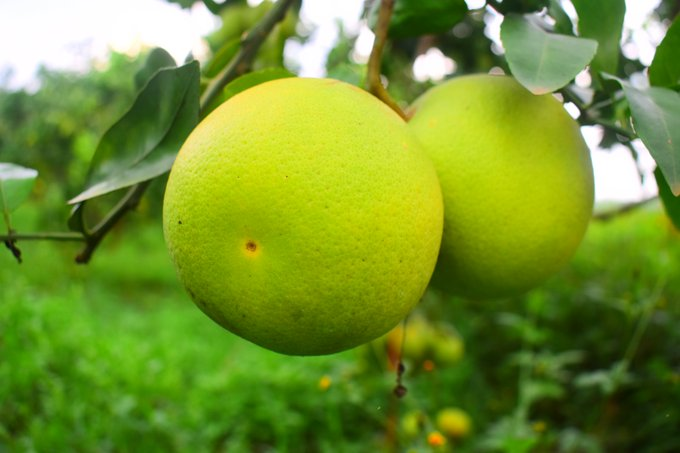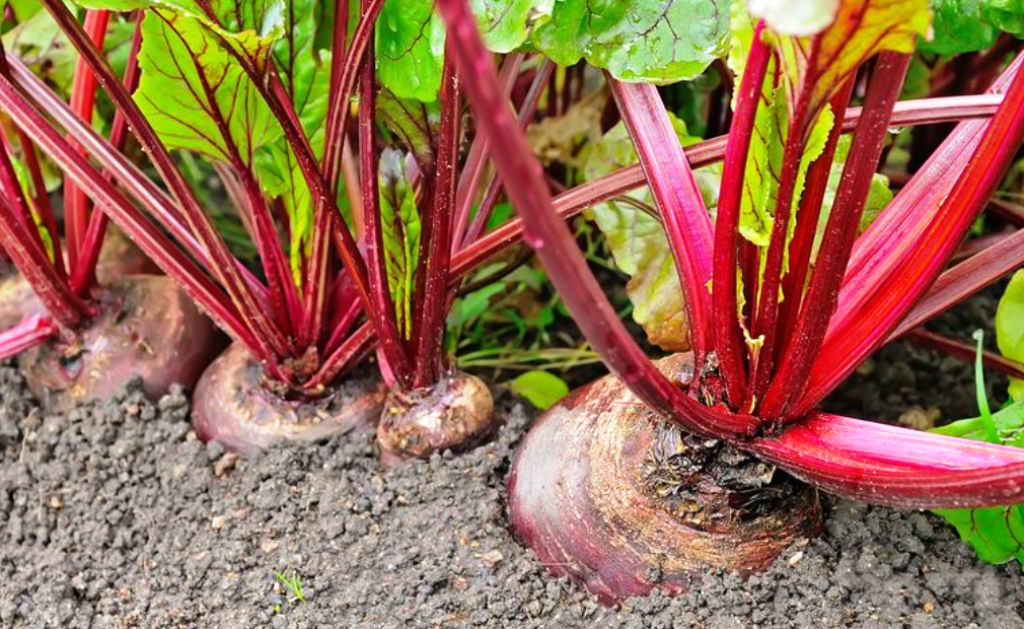Persimmons are a unique, vibrant orange fruit that is a staple of fall and early winter for people worldwide. So if you have ever wanted to grow your own persimmon tree then you’ve come to the right place. Let’s take a look at everything you need to know about growing your own persimmon tree for a delicious harvest of persimmon fruit from your garden.

Persimmon Tree Profile
The persimmon tree belongs to the Diospyros family and originates from China. Persimmons are a deciduous tree, meaning their leaves fall off every winter. Their pink and white flowers bloom during late spring, and the fruit is ready for harvesting in late fall and early winter. During the spring and summer, the persimmon tree’s leaves are a beautiful blue-toned green. Later on in autumn, the leaves transform to a yellow-orange color.
Some varieties of persimmon trees grow to heights reaching 19.5-23 feet (6-7 meters). Though fortunately, you can also grow dwarf and semi-dwarf varieties of persimmon trees. These will grow to a smaller and more manageable 6.5-16 feet (2-5 meters) tall. And this size is perfect for the urban backyard garden.
Like many fruit trees, persimmon trees are slow to fruit. It can take 4-5 years before your persimmon tree will bear fruit but once they do, the results will be worth it!
Persimmon Tree Varieties
There are three types of persimmons grown commercially; the Asian persimmon (Diospyros kaki) and the most important, the Date Plum (Diospyros lotus) and the American persimmon (Diospyros virginiana).
Asian Persimmons
The Asian persimmon is native to Japan and China, and is the most commonly cultivated variety of persimmon. 80% of the world’s persimmon cultivation comes from China. Despite being native to Asia, these persimmons can be grown in other warm climates, such as Florida, Texas, or California. They are also known as Japanese or oriental persimmon.
Date Plum Persimmons
The Date Plum persimmon is native to both southeast Europe and southwest Asia. The fruit is small and tastes like the name suggests; a mix of plum and date. They can be eaten fresh but are often dried. The drying process removes tartness.
American Persimmons
American persimmons are native to eastern North America, making them more cold-hardy than their Asian counterparts. This variety is not commonly cultivated for commercial purposes; however, it is a popular choice among home gardeners looking to add a fruit tree to their home.
American persimmons are classified as astringent; and as such, they must be ripened fully before you can eat them.
Astringent vs. Non-Astringent Persimmons
It’s important to distinguish between the two types of persimmon fruit know as astringent and non-astringent.
Astringent refers to the high soluble tannins in the persimmon at maturity. This produces an overpowering sourness of the persimmon before it reaches ripeness. Astringent persimmons need to ripen to complete softness to reduce the high-water soluble tannins. The Hachiya persimmon is a popular astringent variety.

Non-astringent persimmons lose their astringency or tannin content earlier and can safely be eaten fresh off the tree, much like an apple. The Fuyu variety is a popular non-astringent persimmon.

People alternatively refer to the difference between astringent and non-astringent persimmon as ‘puckering’ (astringent) or ‘non-puckering’ (non-astringent). It’s a fun way to remember the difference. But do keep in mind that astringent persimmons are just as delicious as non-astringent persimmons once they are fully ripened.
Ideal Growing Conditions for a Persimmon Tree
Climate for Growing Persimmon Trees
Persimmon trees are very tolerant of cold weather conditions. The American variety is capable of tolerating air temperatures of around -25° F (-31.5 °C). The Asian variety can tolerate air temperatures as low as 0° F (-18 °C). Persimmon trees typically enjoy temperate and subtropical climates and perform worst in dry, desert conditions.
Soil Requriements for Growing Persimmon Trees
Ideally, persimmons thrive well in loamy soil that is well-draining and rich in organic matter. Though persimmon trees are pretty easygoing when it comes to soil types. Opt for a pH level that is between 6.5 and 7.0.
To increase soil drainage and fertility, you can prepare the soil a few weeks prior to planting by adding compost and well-rotted manure and working them through the soil.
Good soil will help the persimmon tree establish itself and give it the best chance of healthy growth.
Sun Requriments for Persimmon Trees
Persimmons of all varieties enjoy growing in full sunlight, though some light shade in the afternoon is perfectly fine as well. It is important to keep in mind how the changing seasons affect the light in your garden; you’ll want to make sure the trees get ample light all year round to support the persimmons’ fall harvest. So aim to plant your persimmon tree in full sun.
Water Requirements for Persimmon Trees
Mature and established persimmon trees require moderate watering. Depending on your climate and natural rainfall, a deep watering once every week or two during warmer weather and less during the colder weather. Though be sure to water during times of drought.
You should only need to maintain a watering schedule when your persimmon trees are young.
And if you are growing a dwarf variety of persimmon in a large pot, additional watering will be required. Again, depending on your climate and rainfall, in warm weather, pot and container grow fruit trees may need watering every second day or so as they try out quicker than when they’re grown in the ground.
Fertilizer for Persimmon Trees
Persimmon trees do not require a lot of fertilizer, but like most food-producing plants, organic compost and aged manure will help feed the soil and tree, keeping the soil fertile and healthy.
There is some discrepancy as to whether persimmon trees require additional fertilizer. Some good advice is to monitor your tree’s growth and act accordingly.
Signs your persimmon tree may benefit from additional fertilizer are pale leaves and stunted growth. A healthy persimmon tree will have dark green leaves and grow at a rate of approximately 1 foot per year (30 cm).
If you determine your persimmon tree would benefit from fertilizer, besides aged manure and compost, an organic fruit tree fertilizer here would be worthwhile, particularly around springtime when buds are forming.
Keep a good layer of mulch around the tree to help keep in soil moisture and protect the tree roots. Just be sure to keep the mulch away from directly touching the trunk of the tree, which could otherwise cause rot.
Planting a Persimmon Tree

There are multiple ways to grow a persimmon tree; either by seed, cutting, or grafts. Despite the many methods of growing trees, the best method of growing a strong, healthy persimmon tree is via grafting. Grafted persimmon trees will produce fruit that is true to type and are generally faster to fruit.
Plant nurseries carry young grafted persimmon seedlings (about 1 or 2 years old) which can also be sold as bare-rooted trees. Though if you can, it’s a good idea to buy a persimmon tree already in a pot or bag with soil as the bare-rooted plants can be more prone to disease.
These saplings can be easily transferred to any location in your garden. Planting time is best when the persimmon tree is dormant in winter through early spring to prevent transplant shock.
- Choose a sunny location in your garden with around 10-13 feet (3-4 meters) away from other trees to allow the tree room to grow. Persimmon trees don’t like windy locations, so pick a sheltered spot away from strong winds.
- Dig a hole slightly bigger than your pot, give the hole a water but don’t add fertilizer which could be too strong for the roots at this point.
- Plant your persimmon tree up to the same level as the pot.
- Back fill the planting hole with soil and water in well.
- A light addition of compost and a covering of mulch will help get your persimmon tree off to the right start.
- Continue to water the persimmon tree regularly over the few months while the tree settles in. Then you can slowly reduce the water.
Quick Guide to Persimmon Tree Grafting (Advanced Gardener)
Grafting is essentially propagating a piece of a tree and fusing it to another tree. It is composed of a rootstock (the bottom half of a tree that will form the roots), and the scion (the fruit tree clipping that determines the fruit type that will grow).
For the more advanced gardener wanting to give grafting a go, here is a quick guide to grafting:
- During the persimmon’s dormant period, snip off about six inches worth of new growth from one of the tree branches (this is a scion); the piece of wood should have at least three buds on it.
- Wrap the cut end of the scion in a damp paper towel and store them in a plastic zip bag. Make sure to remove as much air as possible before closing the bag. Refrigerate until the tree’s dormancy period is over.
- Every week check your scion to make sure it has not molded. If you do notice mold, clean off the scion with a mix of 10% bleach and 90% water.
- Now, you will need a rootstock; this should be a young, healthy tree (with a trunk that is no more than 4 inches in diameter). Trim this tree until it is one singular trunk that is 3 feet high.
- In the trunk, make a 2 inch deep cleft to wedge the scion into. Wrap the trunk and the scion in grafting tape. Moving forward, take care of your grafted tree and monitor it for growth. Eventually the two pieces will fuse together to form the beginnings of a persimmon tree.
Persimmon Tree Pollination
Pollinating persimmon trees can vary greatly by each variety. Many persimmons are dioecious (meaning trees either bear staminate male or pistillate female flowers). Generally, a male flower must pollinate a female flower in order for a fruit to form. Trees that grow both male and female flowers can be self-pollinating.
Check the variety of persimmon tree you wish to grow to confirm pollination requirements. For example, the American persimmon is not a self-pollinating tree and therefore requires a second tree to pollinate it in order to actually have a harvest of persimmons. While both Hachiya and Fuyu persimmon trees are self-fertile and do not require another tree to pollinate them.
Regardless of the persimmon tree variety, it is highly beneficial to have pollinators in your garden to aid in the delivery of pollen between each flower, and therefore maximize your harvest. Bees are the greatest pollinators of persimmon trees so encouraging bees to visit your garden will reap amazing benefits for your fruit.
You can encourage bees by planting native flowers nearby to attract them. Check out what native flora grows in your local area and add a few patches of wildflowers to bring pollinators to your trees.
How Long Does it Take to Grow a Persimmon Tree

The average time it takes for a persimmon tree to grow into a mature, fruit-bearing tree is anywhere between four and ten years. If you are growing a persimmon tree you have purchased, they are generally a few years old and you could expect the tree to fruit within four to six years of planting.
On the other hand, if you are trying your hand at growing persimmon from seed then the time to fruiting can be significantly longer. You should also know that growing from seed will not result in a true to type and you may end up with a tree that never produces fruit for you. Therefore, stick with the grafted persimmon tree to make sure you will grow a beautiful harvest of persimmon fruit.
Growing persimmons, like many fruit-producing trees, is a fairly long-term time investment for gardeners. On the bright side, homegrown persimmons are so sweet and delicious, it makes the challenge, and your patience, well worth it. And once established, a healthy persimmon tree can live for 60 years!
Pruning Persimmon Trees
Pruning your persimmon tree is an important step in early tree care. With proper pruning in its early formative years, you can assure the mature tree will have a strong main trunk (or multi-trunk) to support the rest of the tree. You can do this by giving the young persimmon tree a light prune in late winter.
Persimmon fruits can grow heavily and consequently, can snap branches that are too weak to support them. Pruning your persimmon tree can help strengthen these branches and prevent breakage.
Mature persimmon trees should have any dead branches removed to encourage growth in healthy branches. But they don’t not need a great deal of pruning. Flowers form on the current season’s branches and heavy pruning will affect your harvest.
Pruning should generally be done after fruiting, so in late winter or early spring.
Harvesting Persimmons
If you are growing astringent persimmons, for example, Hachiya, it’s important to harvest your persimmons when they are fully ripe. Astringent persimmons that have not been allowed to ripen properly will have a chalky, inedible flavor, as opposed to their characteristic sweetness when ripe. You can still harvest them when they are not yet fully ripe and then allow them to further ripen on the kitchen bench in a bowl with a ripe apple or banana. The naturally occuring ethylene gas released from the banana or apple will help to ripen your persimmons.
Non-astringent persimmons are more forgiving; if you are growing non-astringent persimmons, you can easily eat them right from the tree. The texture is crisp like an apple. You can also allow them to ripen further which will soften them somewhat and increase the sugars making them sweeter.
Both varieties of persimmon are ready to harvest during late fall to early winter. The best way to tell a persimmon is ripe is by the change in color from green through to yellow to orange. Persimmons are best harvested using secateurs to avoid damaging the fruit.
After picking your persimmons, they will continue to ripen after they are harvested from the tree. Further ripening will soften the persimmon and develop the sweetest flavor.
Storing Persimmons

Whole persimmons should be stored at room temperature until they are soft and ripe. Afterward, you can store them in the refrigerator to extend their shelf life; often lasting up to 2 weeks.
To make the most of your harvest, you can dice up your persimmons and keep them in the freezer. Frozen persimmons will last in the freezer for up to one year. You can freeze a whole persimmon, however, they only last a few months before its texture and flavor deteriorate.
What Kind of Recipes Can I Make with Persimmons?
Persimmons taste amazing in fall recipes. Definitely take advantage of its delicious honey-like sweetness. Persimmon jam on toast is the perfect fall snack, and it’s an easy recipe to share with your friends and family.
Have a look at this easy recipe for persimmon jam:
6 Persimmons, peeled, seeded, and diced
The juice of half a lemon
1 cup of sugar (preferably granulated)
A pinch of salt
- Add the persimmons and lemon juice to a sauce pan and cook on medium heat for 10-15 minutes, or until the fruit begins to become soft. You can use your cooking utensil to break apart pieces of fruit to soften it more.
- Add the sugar and a pinch of salt and stir the mixture together until the sugar starts to melt. You can continue to crush the fruit to your desired consistency (I like my jam with some chunks of fruit, but that’s entirely up to you).
- After the mixture has become consistent, you can take the pan off the heat and store it in a jar. It will last for approximately one month in the refrigerator.
Persimmon Tree Pests and Diseases
Persimmon trees are fairly hardy once established, but they do still have some pests and diseases you should look out for. The most common are as follows.
Persimmon Tree Pests
Fruit Fly – Fruit fly can be a problem in some areas. And if you live in an area where fruit fly live then you need to protect your persimmon tree as they are a serious pest. The affected fruit will show tiny black spots. Use exclusion bags or cover the persimmon tree in netting after the flowers have had a chance to pollinate. This is the most effective organic method for preventing fruit fly attacks on your persimmon tree.
Mealybugs – Mealybugs are identifiable by their small, white fluffy appearance; they look very similar to little cotton balls. But these bugs can be detrimental to your persimmon plants. Organic solutions are important to rid your tree of mealybugs
Ants – We’ve all had run-ins with these marching menaces before, but they can also attack your fruit trees as well. Luckily, it is easy to stop the spread of ants with natural and non-toxic remedies. The most common method of deterring ants is to spray their pathway with a mix of water and household dish soap. The dish soap works wonders at discouraging the ants from marching onward, while also keeping your fruit safe from pesticides.
Persimmon Tree Diseases
Cercospora Leaf Spot – Characterized by small brown dark spots on the leaves.
Circular Leaf Spot – Watermark halo-like spots on the leaves.
Crown Gall – Galls grow on the crown and roots.
Calyx-separation – A physiological disorder causing a cavity to develop under the calyx of the persimmon. Avoid excess nitrogen fertilizer.
Skin Russeting – Rings form around the fruit. Although the cause is not yet known some possible reasons include irregular watering, thrips attack during the flowering process, too much nitrogen, and high humidity. More commonly found on astringent persimmons such as Hachiya.
Conclusion
The somewhat long-term time investment of growing your own persimmon tree will produce a very sweet reward in the end. Biting into your own homegrown delicious persimmon fruit makes the wait well worth it. And then each year, for years to come, you will be enjoying your own bountiful harvest of tasty persimmons!




